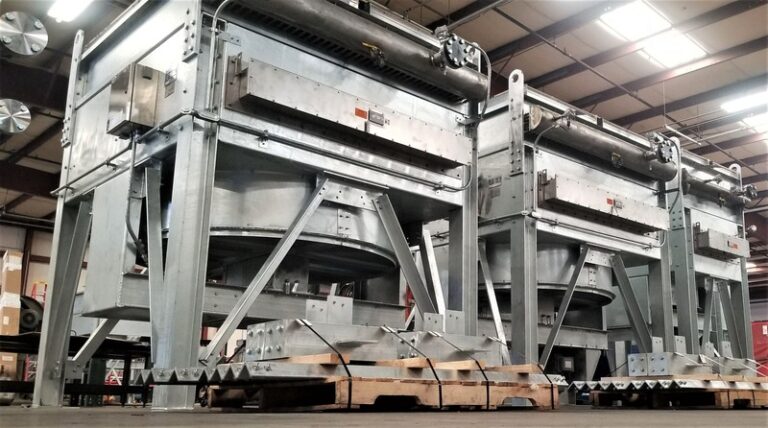Introduction
Heat exchangers renewable energy systems are devices transfer heat between fluids, ensuring that thermal energy is used effectively in technologies that harness renewable resources such as solar, wind, biomass, hydropower, and geothermal energy. Heat exchangers help maximize energy production by efficiently managing temperature variations, preventing energy losses, and enhancing overall system efficiency. They are integral in processes such as solar thermal energy storage, geothermal heating and cooling, and the conversion of biomass into energy. As renewable energy systems continue to evolve and expand, the role of heat exchangers becomes even more critical. Their ability to manage heat in a sustainable way is essential to improving the performance and economic viability of renewable energy technologies, ultimately contributing to the global shift toward cleaner, more sustainable energy sources.
Applications of Heat Exchangers in Renewable Energy
- Solar Thermal Systems: In solar thermal systems, heat exchangers are used to transfer heat absorbed by solar collectors to a fluid, typically water or a heat-transfer fluid, which is then used for heating buildings, producing hot water, or even generating electricity in large-scale CSP plants. The heat exchanger ensures that the heat from the solar collectors is effectively transferred to the storage system without significant thermal losses.
- Geothermal Energy Systems: Geothermal systems utilize the Earth’s natural heat. Heat exchangers in geothermal power plants or geothermal heating systems are responsible for transferring heat between the geothermal reservoir and the working fluid. This fluid is typically circulated in a closed-loop system, where heat exchangers enable efficient heat transfer, making geothermal energy an effective and sustainable power source.
- Biomass Power Generation: Biomass energy, which involves burning organic materials like wood, agricultural residues, or waste to generate electricity, uses heat exchangers to transfer heat from the combustion chamber to a fluid that drives a steam turbine. The heat exchanger ensures that maximum heat is extracted from the biomass combustion process and utilized in the power generation cycle.
- Concentrated Solar Power (CSP): CSP plants use mirrors or lenses to focus sunlight onto a receiver, generating intense heat that is used to produce steam and drive turbines for electricity generation. Heat exchangers are used in CSP systems to transfer the heat from the receiver to the working fluid, ensuring efficient heat conversion and minimizing energy loss.
- Ocean Thermal Energy Conversion (OTEC): OTEC is a method of generating electricity by utilizing the temperature difference between warm surface water and cold deep ocean water. Heat exchangers in OTEC systems are used to facilitate heat transfer between these water layers, helping generate electricity through a Rankine cycle, making use of the natural temperature gradient in oceans.
Benefits of Heat Exchangers in Renewable Energy
- Heat Recovery and Sustainability: Heat exchangers ensure that renewable energy systems can recover and reuse waste heat, improving sustainability by minimizing waste and reducing the need for additional energy input.
- Optimized Energy Flow: Heat exchangers can improve the flow of energy between various parts of a renewable energy system, increasing the overall effectiveness of the system by ensuring that heat is transferred efficiently to where it is needed most.
- Reduced Carbon Footprint: By maximizing heat transfer and reducing the need for fossil fuels or supplementary energy sources, heat exchangers contribute to reducing the carbon footprint of renewable energy systems.
- Cost Reduction in Long-Term Operation: Heat exchangers increase the efficiency of renewable energy systems by reducing operating costs. With improved heat management, there is less wear and tear on components, extending the system’s lifespan and reducing the frequency of maintenance.
- Energy Storage Integration: Heat exchangers can integrate seamlessly with thermal energy storage systems like molten salts or phase-change materials, enabling energy storage for later use when renewable resources (solar, wind, etc.) are intermittent. This makes renewable energy more reliable and accessible, even during times of low energy generation.
Innovations and Future Trends in Heat Exchanger for Renewable Energy
- Advanced Composite Materials: The future of heat exchangers in renewable energy will involve the development of advanced composite materials that are lighter, more heat-resistant, and capable of withstanding harsh environmental conditions, thereby improving heat exchange performance and increasing the lifespan of equipment.
- Microchannel Heat Exchangers: With increasing demands for compact and efficient systems, microchannel heat exchangers, which use small channels to transfer heat, are becoming more popular. These heat exchangers offer higher surface area-to-volume ratios, leading to better heat transfer in smaller spaces, ideal for use in renewable energy systems with limited space.
- Supercritical CO2 (sCO2) Cycles: Supercritical CO2 power cycles are gaining attention as a highly efficient method of energy conversion for renewable systems. Heat exchangers in these cycles must handle CO2 at supercritical pressures and temperatures, and advancements in materials and design will improve performance in these systems.
- Heat Exchanger Network Optimization: The future of heat exchangers will involve the development of smart heat exchanger networks that are optimized using AI and machine learning to manage heat transfer based on real-time data, improving overall energy efficiency and adapting to fluctuating energy demands.
- Waste Heat to Power Systems: New designs in heat exchangers are enabling waste heat from renewable energy plants to be converted into electricity using technologies like Organic Rankine Cycles (ORC). These systems are gaining popularity for small- to medium-scale renewable projects, such as geothermal and biomass plants.
Conclusion
heat exchanger are indispensable for the advancement of renewable energy systems, enabling greater energy efficiency and sustainability. By efficiently managing heat within renewable energy technologies, heat exchangers reduce energy wastage, increase system reliability, and lower operating costs, all of which are essential for maximizing the potential of renewable resources. With the growing importance of renewable energy in reducing global carbon emissions, heat exchangers will continue to play a key role in the development of efficient, cost-effective, and environmentally-friendly energy solutions. Furthermore, as technology advances, we can expect innovations in heat exchanger design and materials that will further enhance their performance, making them even more essential in supporting the ongoing global transition to sustainable energy.

